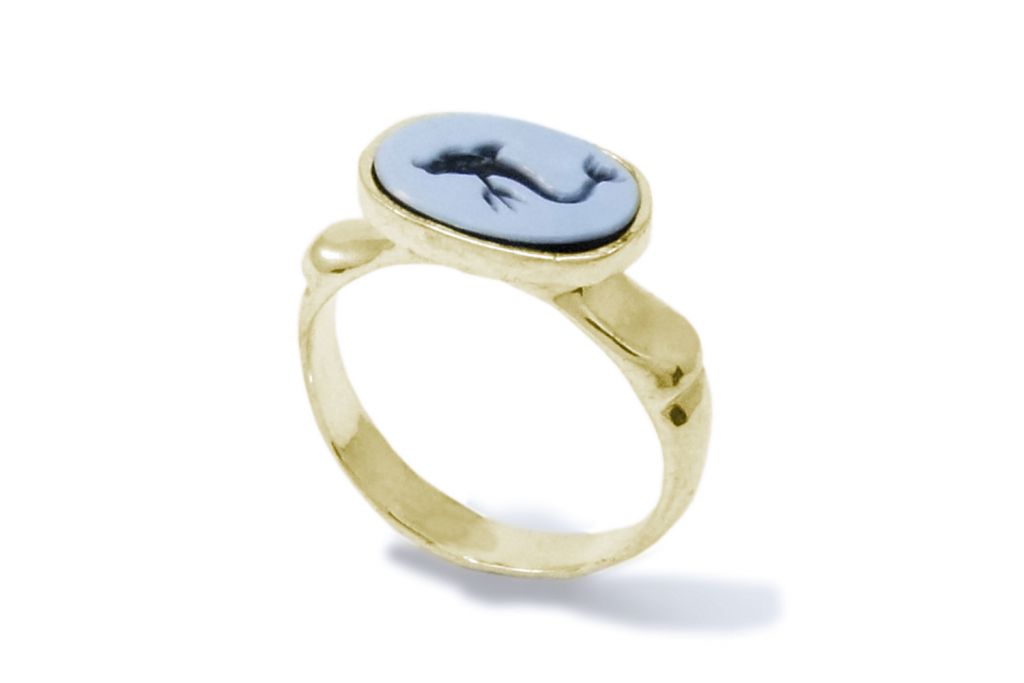Roman Ring with Dolphin Intaglio, Gold
Roman signet ring handmade from solid gold with intaglio made from genuine layered onyx. Depicted is a dolphin. In antiquity, this animals were regarded as symbols of beauty, happiness and love, associated with Cupid and Venus. The depiction of the dolphin is based on a gem from the Staatliche Museen of Berlin.
Roman Ring with Dolphin Intaglio
Roman finger ring handmade from solid gold with intaglio made from genuine layered onyx. Depicted is a dolphin. In antiquity, animals were regarded as symbols of beauty, happiness and love, associated with Cupid and Venus. The depiction of the dolphin is based on a gem from the Staatliche Museen zu Berlin.
The intaglio comes from a master workshop that can draw on years of experience in working with antique techniques and patterns. In collaboration with my replica workshop, wonderful individual pieces of jewellery of the highest quality are created.
A ring like this will accompany you for many years and inspire you with its authentic motif!
As the gem and the finger ring are made by hand in your individual size, you can expect a delivery time of around 4-5 weeks.
They are delivered in a jewellery box with a certificate.
The Dolphin In Antiquity
The dolphin played an important role in ancient culture and mythology. In many ancient civilisations, the dolphin was seen as a symbol of freedom, protection and happiness, and not only by seafarers.
In ancient mythology, there is an interesting connection between dolphins, Cupid and Venus. Cupid, also known as Eros to the Greeks, was the god of love, while Venus was the goddess of love and beauty. Dolphins were often associated with these two deities.
One well-known story is that of Cupid and Psyche. Psyche was a mortal woman of whom Venus was jealous, as she was considered by many to be even more beautiful. Venus instructed Cupid to make Psyche fall in love with an ugly man. But when Cupid saw Psyche, he fell in love with her himself and abducted her to his kingdom.
In some depictions of this story, Cupid is often accompanied by dolphins. Dolphins were seen as loyal and loving animals that had a connection to love. They were seen as messengers of love and symbolised joy and happiness.
In addition, Venus was often associated with dolphins. In Roman mythology, she was often referred to as "Venus Marina", which means "Venus of the sea". Dolphins were seen as her companions and were considered her faithful companions.
This connection between dolphins, Cupid and Venus shows the close relationship between love, beauty and the sea. The dolphins symbolise the joy and happiness associated with love, while Cupid and Venus represent the divine forces that guide love.
Overall, the connection between dolphins, Cupid and Venus is a fascinating element of ancient mythology that illustrates the importance and beauty of love in various forms and guises. Overall, the dolphin played an important role in ancient beliefs and was seen as a creature of great importance and beauty.
Gem Rings In Antiquity
Gem rings, i.e. finger rings with inlaid, decorated gemstones, are among the most numerous and varied pieces of archaeological jewellery from antiquity;
Gems are divided into two types: the sculpted raised motif, the cameo, and the engraved itaglio. Agate, carnelian, onyx or other precious stones were used as materials. Particularly popular and beautiful to look at due to their multicoloured nature are colour-layered stones using the Nicolo technique, in which the engraved motif stands out in a different colour.
Gem rings were not only used as pieces of jewellery, but also had various practical uses and symbolic meanings:
Signet rings
Some Roman gem rings were used as seal rings. The engraved gem was pressed into hot wax or clay to seal documents or letters. The seal showed the individual symbol or name of the owner.
Amulets and talismans
Many gems had religious or protective symbols or inscriptions that were worn as amulets or talismans to bring good luck or protect against evil influences.
Status symbols
Some wealthy Romans wore gem rings as status symbols to show their wealth and social status. These rings could have elaborate gemstones and ornate engravings.
Jewellery
Of course, many Roman gem rings were simply used as pieces of jewellery. They were often prized for their ornate engravings and the beauty of the gemstones used. Men also often wore elaborate and eye-catching finger rings.
Roman gem rings are also important historical artefacts as they give us insights into Roman art, culture and history. The engravings on the gems can depict mythological scenes, portraits of famous people, historical events and other important motifs that were significant to the Romans. These rings are often found in museums and collections today and are valued as important testimonies to Roman civilisation.
Production of gem rings in antiquity
The intaglios were produced in an elaborate handcrafted process:
Selection of the raw material
Firstly, the artisan selected the appropriate semi-precious stone to create the intaglio. Different types of stone had different degrees of hardness and colours, which influenced the choice of the right material.
Shaping the stone
The selected stone was roughly moulded into the desired shape, often by sawing, grinding or scraping. This made it possible to shape the rough contour of the future intaglio. A powder or granulate of hard corundum stone, which was mixed with olive oil and used in various grain sizes and is harder than the jewellery stone, was probably used as an abrasive and cutting agent.
Drawing of the design
The artist sketched the intended design on the flat surface of the stone. This sketch served as a template for the actual engraving.
Engraving of the design
Using special tools, the artist began to cut or engrave the motif into the stone. Presumably, a kind of lathe was used, which was driven by a bow and had an engraving point attached to it. The use of metal points and corundum powder is obvious, but with the means available it was an extremely lengthy and strenuous process to cut the motif into the stone. The artist always had to precisely control the depth and width of the engravings. Depending on the desired effect, this could take weeks or months.
Even in antiquity, the quality of the craftsmanship varied from simple rough line patterns to small masterpieces in which every little detail of the motif was exquisitely crafted.
Polishing and finishing
Once the design was finalised, the stone was thoroughly polished to make the engravings and the stone itself shine. This was often achieved with fine sand, pumice stone or other abrasive materials.
Framing in jewellery or utility item
The finished intaglio was set into a piece of jewellery, a signet ring or another everyday object to protect and present it.
The quality of an intaglio depended on the skill of the artist, the choice of material and the precision of the engraving. These artefacts were often highly prized for their artistic and craftsmanship quality as well as their historical or symbolic value. Intaglio artefacts were not only produced in antiquity, but also remained popular in later eras right up to the modern day.
| Delivery time | 6-8 weeks |
|---|---|
| weight | 0.012000 |
| Era | Romans |
| Material | Gold |
| Kind of replica | Rings With Intaglios |
| scope of delivery | Delivery in a jewellery case with certificate |

